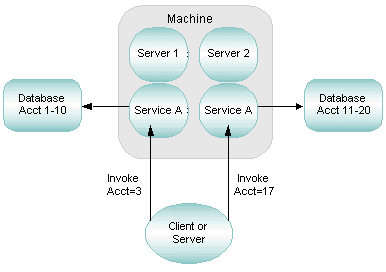


|

|
|
|
|
How to Use Data-Dependent Routing
Data-dependent routing is useful when clients issue service requests to:
A horizontally-partitioned database is an information repository that is divided into segments, each of which is used to store a different category of information. This arrangement is similar to a library in which each shelf of a bookcase holds books for a different category (for example, biography, fiction, and so on).
A rule-based server is a server that determines whether service requests meet certain, application-specific criteria before forwarding them to service routines. Rule-based servers are useful when you want to handle requests that are almost identical by taking slightly different actions for business reasons.
Note: For detailed information about factory-based routing for a distributed BEA Tuxedo CORBA application, refer to the Scaling, Distributing, and Tuning CORBA Applications guide.
Example of Data-dependent Routing with a Horizontally-partitioned Database
Suppose two clients in a banking application issue requests for the current balance in two accounts: Account 3 and Account 17. If data-dependent routing is being used in the application, then the BEA Tuxedo system performs the following actions:
The following figure illustrates this process.
Data-dependent Routing with a Horizontally-partitioned Database
Example of Data-dependent Routing with Rule-based Servers A banking application includes the following rules:
Two clients issue withdrawal requests: one for $100 and one for $800. If data-dependent routing is enabled to support the withdrawal rules, then the BEA Tuxedo system performs the following actions:
The following figure illustrates this process.
Data-dependent Routing with Rule-Based Servers

|

|

|
|
|
|
Copyright © 2001 BEA Systems, Inc. All rights reserved.
|